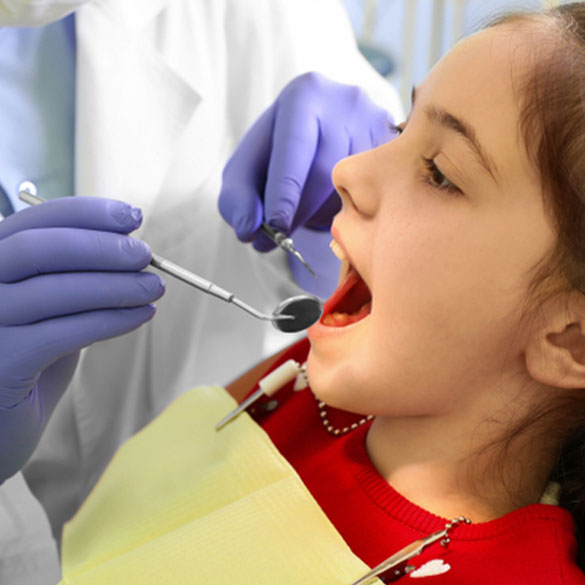Pediatric Dentistry:
Milk teeth are more susceptible to caries and there is a high chance that the infections from the milk teeth will spread directly to the permanent tooth. Kids Dentistry deals with the problems associated with milk teeth and the oral habits of children through adolescence.
Without proper dental care, children are at risk of developing oral decay and disease, which can lead to a lifetime of pain and complications. About 80% of children suffer from dental caries.

Tooth Coloured Fillings
Preventive Care
Painless Treatments
Treatments Commonly Performed in Pediatric Dentistry
- Tooth-colored fillings
- Treatment of misaligned teeth
- Space Maintainers
- Habit counseling
- Pediatric Pulp Therapy.
- Extractions
- Preventive treatments:
Pediatric dentistry - Tooth Colored Fillings (Composite Resin):
- When restoring the front or back teeth or when aesthetics are crucial, tooth-colored fillings are employed.
- Composites are utilized to fix cracked teeth as well as decayed areas.
- The color of the composite restorative material is closely matched to the shade of the natural teeth.
Pediatric dentistry - Treatment of misaligned teeth:
- Braces are needed in case of any teeth alignment issues.
- Braces should be put on between the ages of 10 and 14 when the mouth and face are still developing and the teeth are more amenable to straightening.
Space maintainers:
- When a primary tooth has been pulled or lost too soon, space maintainers are utilized to hold space for the coming permanent teeth.
- If the area around the extraction site is not kept clear, teeth on either side may drift into the space and prevent the permanent tooth from emerging into its ideal position leading to misalignment of the teeth.
Pediatric dentistry - Habit-breaking appliances:
- A few oral habits like thumb sucking, tongue thrusting, mouth breathing, and nail biting are harmful to the teeth and teeth-supporting structures.
- The risk of dental problems is related to how often, how long, and how intensely your child does the habit.
- These harmful habits can be avoided by using habit-breaking appliances.
Pulp therapy:
- The treatment for infected nerves and blood vessels in teeth is called pulp therapy
- In most cases, pulp therapy is required either as a result of severe tooth decay (dental cavities) or as a result of tooth trauma.
- When this occurs, the nerve's contaminated portion needs to be removed. We'll preserve and treat the nerve that is still healthy. This prevents the need for extraction and a space maintainer
Stainless steel crowns:
- Back teeth that are too severely deteriorated to support fillings are restored with stainless steel crowns.
- To protect the primary (baby) teeth from additional harm until these teeth are lost naturally, these prefabricated crowns are fitted and subsequently cemented onto the teeth.
Extraction:
- Extractions are done only as a last resort in the case of severe tooth decay.
- Some extractions are needed for orthodontic reasons to help facilitate tooth alignment when crowded teeth are present.
Pediatric dentistry - Preventive treatments:
- Fluoride treatment
- Fluoride will be administered to the teeth after the cleaning to help strengthen and protect the vulnerable areas against decay.
- Pit and fissure sealants
- The chewing surface of back teeth has pits and fissures where food and debris get trapped and cause cavities.
- To prevent the cavities pit and fissures are filled using pit and fissure sealants
- Dental cleaning
- The general health of your child's mouth will be checked by your dentist. Your child's teeth will then be completely cleaned to get rid of plaque and calculus, which can lead to Gum diseases and cavities.
Frequently Asked Questions
Answer: A child's first visit to the dentist should take place by the age of one, or within six months of the eruption of the first tooth.
Answer:
- Do not neglect your child oral health.
- Tooth decay is still the most common chronic childhood disease and if left untreated, it can impair a child's ability to eat, speak, sleep and learn.
Answer:
- YES, as soon as your child has a tooth, plaque can begin building up on the surface of the tooth and cause decay.
- Brushing is one of the main ways you can keep your child's teeth healthy.
- You should brush your child's teeth with fluoride toothpaste twice each day to help prevent tooth decay (cavities).
Answer: Regardless of age, it is critical to maintain oral hygiene and keep the mouth clean and germ-free. Mothers can use a soft cloth to clean their children's mouths, both upper and lower jaws.
Answer: Bring your child to the dentist if he or she does not have any baby teeth by the age of 12 months. If their remaining baby teeth haven't erupted by the age of four, they should see a dentist.

